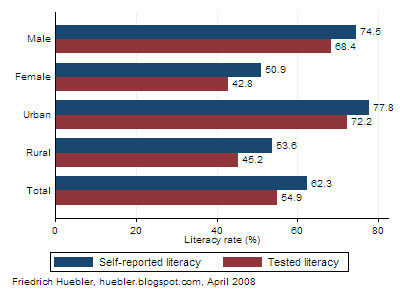The Nigeria DHS of 2003 collected literacy data with two methods. First, the survey questionnaire contained the question: "Can (name) read and write in any language with understanding?" This question was asked for all household members aged 5 years and older, with two possible answers: yes or no (NPC and ORC Macro 2004: 247). The results of this literacy assessment were described in the article "Adult literacy in Nigeria", published on this site on 5 April 2008.
Second, a randomly selected subsample of women between 15 and 49 years and men between 15 and 59 years were asked to read a card with a simple sentence in their language. If the respondent could not read the whole sentence, the survey staff were asked to probe if the respondent could read any part of the sentence. The result was recorded as one of three options: (1) cannot read at all, (2) able to read only parts of sentence, or (3) able to read whole sentence. If no card in the respondents' language was available, or if the respondent was blind or visually impaired, the result was recorded in a separate category (NPC and ORC Macro 2004: 26-27).
The graph and table below compare the data from the two literacy assessment methods - self-reporting and reading test - for the population aged 15 to 49 years. The self-reported literacy rate, the blue bars in the graph, is the share of respondents that claimed to be able to read and write. The tested literacy rate, the red bars in the graph, is the share of respondents that could read a complete sentence; household members who could only read parts of a sentence were counted as illiterate.
Self-reported and tested literacy in Nigeria, population 15-49 years

Source: Nigeria Demographic and Health Survey 2003
A comparison of the self-reported and tested literacy rates in Nigeria shows that self-reporting tends to overestimate the degree of literacy in the population. 62 percent of men and women between 15 and 49 years were reported as able to "read and write in any language with understanding". However, the reading test revealed that only 55 percent could read a simple sentence. The difference of 7 percent can be explained by the fact that survey respondents are reluctant to admit that they themselves or other household members, on whose behalf they respond, are unable to read and write. This gap between self-reported and tested literacy can be observed across all groups of respondents: men, women, urban residents, and rural residents. The biggest difference exists in rural areas of Nigeria, were 54 percent of respondents claim to be literate but only 45 percent can in fact read.
Self-reported and tested literacy in Nigeria, population 15-49 years
| Self-reported literacy rate (%) | Tested literacy rate (%) | Difference (%) | |
| Male | 74.5 | 68.4 | 6.1 |
| Female | 50.9 | 42.8 | 8.1 |
| Urban | 77.8 | 72.2 | 5.6 |
| Rural | 53.6 | 45.2 | 8.4 |
| Total | 62.3 | 54.9 | 7.4 |
References
- National Population Commission (NPC) [Nigeria] and ORC Macro. 2004. Nigeria Demographic and Health Survey 2003. Calverton, Maryland: National Population Commission and ORC Macro. (Download report, PDF format, 4 MB)
- Adult literacy in Nigeria
- Adult literacy rates
- Disparity between male and female literacy rates
- Years of schooling and literacy: Can everyone with primary education read and write?
- Demographic and Health Surveys (DHS)
- Nigeria Demographic and Health Survey 2003
- Multiple Indicator Cluster Surveys (MICS)
- U.S. National Assessment of Adult Literacy
Permanent URL: http://huebler.blogspot.com/2008/04/self-reported-and-tested-literacy-in.html
No comments:
Post a Comment